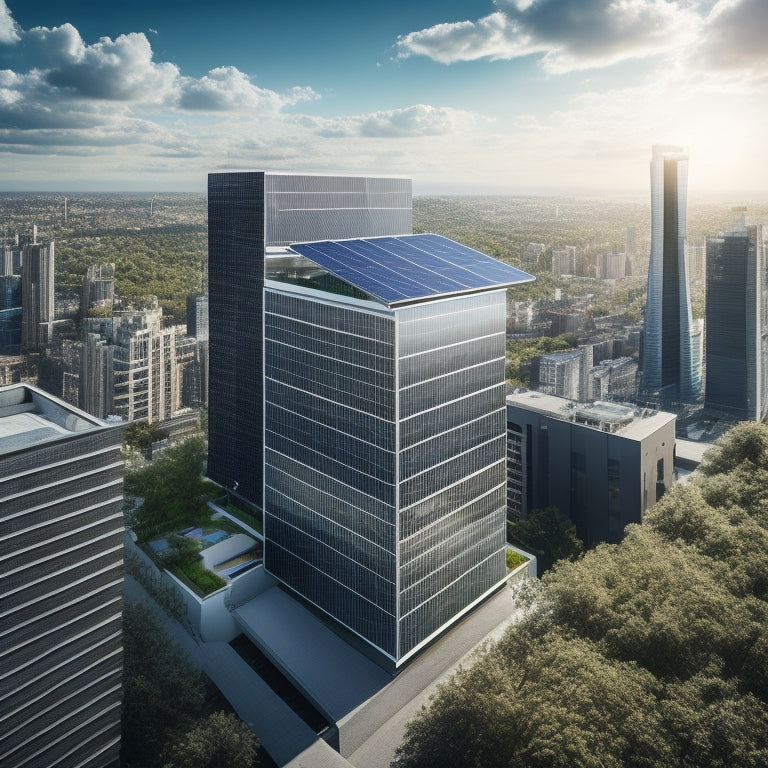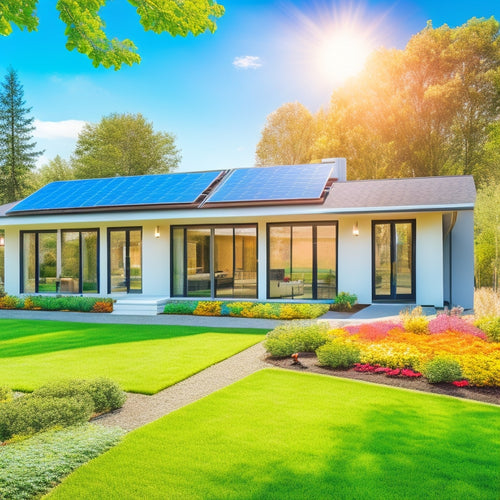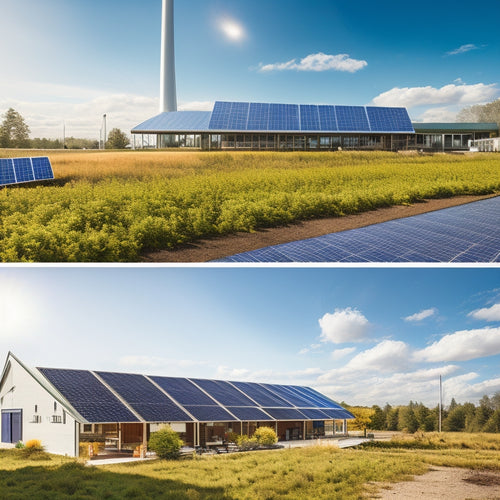
Comprehensive Solar Options Installation for Buildings
Share
You're considering extensive solar options for your building, and you'll want to weigh the benefits of rooftop solar installations, including reduced reliance on traditional power grids and enhanced building reputation. You'll need to choose from various solar panel installation methods, including ballasted and penetrating installations, and decide between roof-mounted, ground-mounted, and building integrated photovoltaics (BIPV) systems. Each option has its unique requirements and considerations, from panel type and installation costs to site selection and structural integrity. By understanding these intricacies, you'll be able to optimize your solar energy system for maximum efficiency and cost savings, and reveal its full potential.
Key Takeaways
- Building owners can choose from roof-mounted, ground-mounted, and building-integrated solar options to suit their unique installation needs and constraints.
- Selecting the right solar panel type and installation method is crucial for optimal energy generation, cost savings, and minimal maintenance requirements.
- Roof-mounted systems are ideal for buildings with limited land availability, while ground-mounted systems offer economies of scale with larger installations.
- Building integrated photovoltaics (BIPV) can enhance property value and sustainability image while reducing energy costs, but require careful design and structural considerations.
- A comprehensive solar installation plan should consider factors like energy requirements, site conditions, and local building codes to ensure a reliable and efficient system.
Benefits of Solar Energy Systems
Your building's rooftop can become a notable asset with the installation of solar energy systems, utilizing the power of the sun to generate electricity. By leveraging this renewable energy source, you'll greatly reduce your reliance on traditional power grids, resulting in considerable cost savings.
Solar energy systems can provide a steady stream of electricity, reducing your energy bills and increasing your bottom line.
Moreover, solar energy systems have a significant environmental impact. By generating clean energy, you'll reduce your carbon footprint and contribute to a sustainable future.
Solar energy is a zero-emission source, producing no greenhouse gases or pollutants, making it an attractive option for environmentally conscious building owners.
With the increasing awareness of climate change, investing in solar energy systems can enhance your building's reputation and appeal to environmentally responsible tenants.
Solar Panel Installation Methods
Installing solar panels on your building's rooftop requires careful contemplation of the installation method to guarantee a secure, efficient, and durable system.
You must evaluate the type of solar panel you're using, as different types have unique installation requirements. For instance, thin-film solar panels are more flexible and can be installed on curved surfaces, while crystalline silicon solar panels are more rigid and require a fixed mounting system.
You'll also need to take into account the installation costs, which vary depending on the complexity of the installation and the type of equipment used. A ballasted installation, where the solar panels are held in place by weights, is generally less expensive than a penetrating installation, which involves anchoring the panels to the roof with screws or bolts.
Additionally, the installation method can affect the system's maintenance and repair requirements. By choosing the right installation method for your solar panel type, you can guarantee a reliable and efficient system that meets your power needs.
Roof-Mounted Solar Options
When evaluating solar options for your building, roof-mounted systems are a popular choice due to their sleek design and efficient energy harvesting. These systems involve installing solar panels directly onto your roof, which can be an ideal solution for buildings with limited land availability.
| Solar Panel Types | Installation Challenges | Benefits |
|---|---|---|
| Monocrystalline | Require precise angle and orientation | High energy conversion efficiency |
| Polycrystalline | Can be affected by roof obstructions | Cost-effective and durable |
| Thin-Film | May require additional structural support | Flexible and lightweight |
As you consider roof-mounted solar options, it's crucial to choose the right solar panel type for your building. Monocrystalline panels offer high energy conversion efficiency, but require precise angle and orientation. Polycrystalline panels are cost-effective and durable, but can be affected by roof obstructions. Thin-film panels are flexible and lightweight, but may require additional structural support. By understanding the installation challenges and benefits of each type, you can make an informed decision for your building's energy needs.
Ground-Mounted Solar Systems
Ground-mounted solar systems offer a strong alternative to roof-mounted solutions, particularly for buildings with ample land availability or those requiring a larger scale of energy production.
As you contemplate this option, you'll need to carefully analyze the site selection process. This involves evaluating the terrain, soil condition, and vegetation to confirm the ground can support the system's weight and optimize energy output. You'll also need to reflect on the system's layout and configuration to minimize shading and maximize energy production.
When it comes to installation costs, ground-mounted systems can be more expensive than roof-mounted solutions due to the additional infrastructure required, such as concrete foundations and mounting structures.
However, the benefits of increased energy production and reduced maintenance costs can surpass the higher upfront investment. Additionally, you may be able to take advantage of economies of scale by installing a larger system, which can reduce the overall cost per unit of energy produced.
Building Integrated Photovoltaics
About 80% of commercial buildings can benefit from building integrated photovoltaics (BIPV), which seamlessly merge solar panels with building envelopes to generate electricity while serving as a functional part of the structure.
By integrating solar panels into your building's design, you can reduce energy costs, increase property value, and showcase your commitment to sustainability.
When designing a BIPV system, you'll need to take into account several factors. First, assess your building's energy requirements and determine the ideal system size.
Next, evaluate the structural integrity of your building to confirm it can support the added weight of the solar panels. Aesthetic integration is also vital, as BIPV systems should complement your building's design.
You'll need to choose a system that blends seamlessly with your building's appearance, guaranteeing a cohesive look.
Design considerations, such as panel orientation, tilt, and spacing, will also impact your system's performance.
Additionally, you'll need to verify that your BIPV system meets local building codes and regulations.
Frequently Asked Questions
What Are the Maintenance Requirements for Solar Energy Systems?
You'll need to perform regular maintenance on your solar energy system to guarantee maximum efficiency, including panel cleaning to remove debris and inverter servicing to prevent overheating, assuring your system runs at peak performance.
Can Solar Panels Be Installed on Old or Historic Buildings?
You're not limited to installing solar panels on brand-new buildings; you can retrofit even the oldest, most iconic structures, but you'll need to tackle complex solar design considerations and historic preservation challenges head-on, ensuring a seamless blend of old and new.
Are There Any Government Incentives for Solar Installations?
You'll benefit from federal and state tax credits for installing solar panels, as they're classified as renewable energy sources; these incentives can greatly reduce your upfront costs, making your investment more financially attractive.
How Does Solar Energy Affect Property Value and Resale?
As you sow the seeds of solar energy, your property's value blossoms, much like a garden nourished by sunlight. A property appraisal will likely reflect the solar energy benefits, increasing your property's worth, making it a more attractive harvest for potential buyers.
Can I Install Solar Panels on a Rental Property?
You'll need to negotiate tenant agreements and obtain landlord permissions before installing solar panels on a rental property, ensuring both parties benefit from the investment and clarifying responsibilities for maintenance and energy cost savings.
Conclusion
As you consider extensive solar options for your building, remember that the possibilities are endless - a solar-powered utopia is within your grasp! With the right installation method, you can utilize the sun's energy to power your entire operation, slashing energy bills and carbon emissions in the process. By choosing the perfect blend of roof-mounted, ground-mounted, and building-integrated photovoltaics, you'll be bathing in a sea of clean energy, with a ROI that's simply astronomical!
Related Posts
-

How Solar Panels Increase Property Value
Installing solar panels considerably increases your property value by improving energy efficiency and attracting eco-...
-

Eco-Friendly Home Design Ideas for Beginners
If you're starting your eco-friendly home design expedition, focus on sustainable materials like recycled wood or rec...
-

Off-Grid Solar Solutions for Eco-Conscious Businesses
Off-grid solar solutions offer you a path to both sustainability and substantial cost savings. By adopting these syst...


